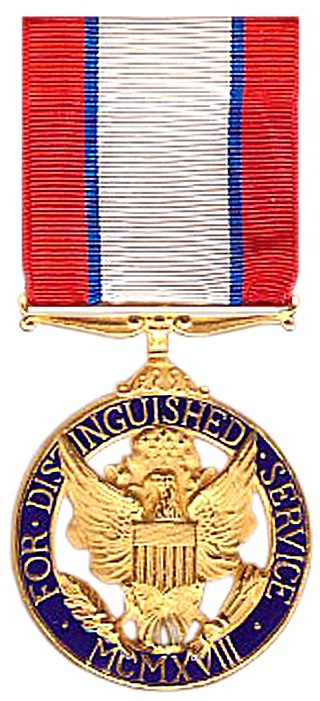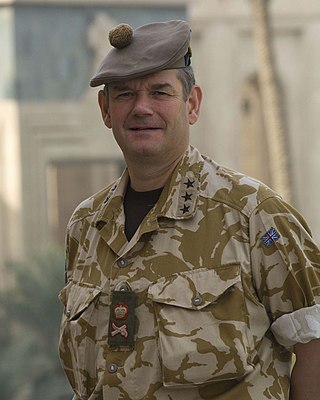
The Distinguished Service Medal (DSM) is a military decoration of the United States Army that is presented to soldiers who have distinguished themselves by exceptionally meritorious service to the government in a duty of great responsibility. The performance must be such as to merit recognition for service that is clearly exceptional. The exceptional performance of normal duty will not alone justify an award of this decoration.
A general officer is an officer of high rank in the armies, and in some nations' air forces, space forces, and marines or naval infantry.

Field Marshal John Standish Surtees Prendergast Vereker, 6th Viscount Gort, was a senior British Army officer. As a young officer during the First World War, he was decorated with the Victoria Cross for his actions during the Battle of the Canal du Nord. During the 1930s he served as Chief of the Imperial General Staff. He is best known for commanding the British Expeditionary Force that was sent to France in the first year of the Second World War, only to be evacuated from Dunkirk the following year. Gort later served as Governor of Gibraltar and Malta, and High Commissioner for Palestine and Transjordan.
Air vice-marshal is a air officer rank used by some air forces, with origins from the Royal Air Force. The rank is also used by the air forces of many countries which have historical British influence and it is sometimes used as the English translation of an equivalent rank in countries which have a non-English air force-specific rank structure.
A flag officer is a commissioned officer in a nation's armed forces senior enough to be entitled to fly a flag to mark the position from which the officer exercises command.
The Deputy Chief of the Defence Staff is a senior British military officer who reports to the Chief of the Defence Staff and Vice-Chief of the Defence Staff.

Lieutenant General Sir John Northcott was an Australian Army general who served as Chief of the General Staff during the Second World War, and commanded the British Commonwealth Occupation Force in the Occupation of Japan. He was the first Australian-born Governor of New South Wales.

The Defence Academy of the United Kingdom provides higher education for personnel in the British Armed Forces, Civil Service, other government departments and service personnel from other nations. The Director General of the Defence Academy is Lieutenant General Thomas Copinger-Symes, a senior Army officer.
General is the highest rank achievable by serving officers of the British Army. The rank can also be held by Royal Marines officers in tri-service posts, for example, Generals Sir Gordon Messenger and Gwyn Jenkins, former and current Vice-Chief of the Defence Staff. It ranks above lieutenant-general and, in the Army, is subordinate to the rank of field marshal, which is now only awarded as an honorary rank. The rank of general has a NATO-code of OF-9, and is a four-star rank. It is equivalent to a full admiral in the Royal Navy or an air chief marshal in the Royal Air Force.

Lieutenant general, formerly more commonly lieutenant-general, is a senior rank in the British Army and the Royal Marines. It is the equivalent of a multinational three-star rank; some British lieutenant generals sometimes wear three-star insignia, in addition to their standard insignia, when on multinational operations.
General is the second-highest rank, and the highest active rank, of the Australian Army and was created as a direct equivalent of the British military rank of general; it is also considered a four-star rank.

The title Surgeon-General has been used for different purposes at different times in the United Kingdom. Initially it was the designation of a director of the Army's medical services. Subsequently it was a senior rank in the Army Medical Department. Having lapsed after the First World War, the title was again revived in the late 20th century for the most senior uniformed medical officer in the British Armed Forces. Currently, it pertains to a senior uniformed medical officer, working under the Director General Defence Medical Services.
The New Year Honours 1964 were appointments in many of the Commonwealth realms of Queen Elizabeth II to various orders and honours to reward and highlight good works by citizens of those countries. They were announced on 1 January 1964 to celebrate the year passed and mark the beginning of 1964.
The King's Birthday Honours 1950 were appointments in many of the Commonwealth realms of King George VI to various orders and honours to reward and highlight good works by citizens of those countries. The appointments were made to celebrate the official birthday of the King, and were published in supplements to the London Gazette of 2 June 1950 for the British Empire, Australia, Ceylon and New Zealand.
The 1949 King's Birthday Honours were appointments by many of the Commonwealth Realms of King George VI to various orders and honours to reward and highlight good works by citizens of those countries. The appointments were made "on the occasion of the Celebration of His Majesty's Birthday", and were published in supplements to the London Gazette of 3 June 1949 for the British Empire, New Zealand, India and Ceylon.
The 1943 New Year Honours were appointments by King George VI to various orders and honours to reward and highlight good works by citizens of the United Kingdom and British Empire. They were announced on 29 December 1942.
The Assistant Chief of the Defence Staff (ACDS) is a senior British military officer. There are a number of ACDS appointments and they are held by officers of two-star rank. They work in the Ministry of Defence.
The 1942 New Year Honours were appointments by King George VI to various orders and honours to reward and highlight good works by citizens of the United Kingdom and British Empire. They were announced on 30 December 1941.
The 1941 New Year Honours were appointments by King George VI to various orders and honours to reward and highlight good works by citizens of the United Kingdom and British Empire. They were announced on 31 December 1940.
Brigadier John Alan Lyde Caunter was a senior British Army officer and a pioneer shark angler off the British coast. He published an account of his escape from Germany as a prisoner of war in World War I.





